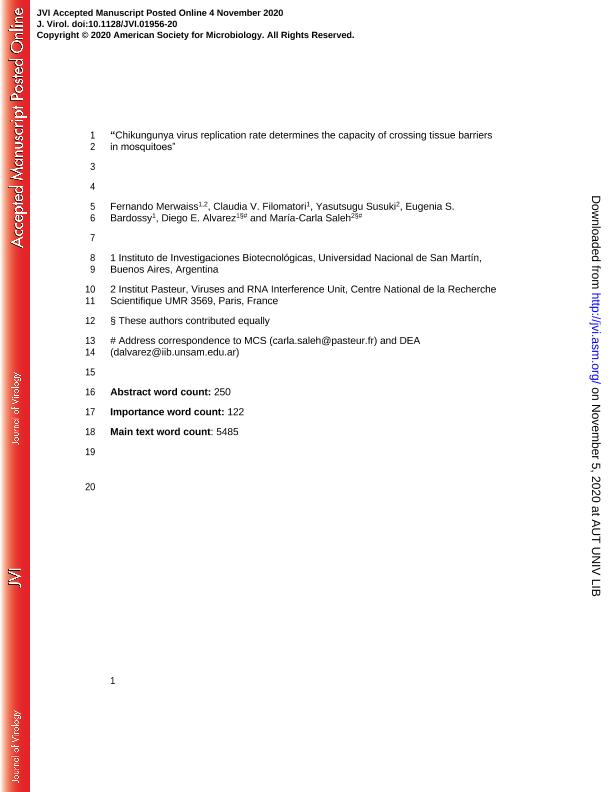Mostrar el registro sencillo del ítem
dc.contributor.author
Merwaiss, Fernando

dc.contributor.author
Filomatori, Claudia Veronica

dc.contributor.author
Susuki, Yasutsugu
dc.contributor.author
Bardossy, Eugenia Soledad

dc.contributor.author
Alvarez, Diego Ezequiel

dc.contributor.author
Salehb, María Carla
dc.date.available
2023-01-19T12:58:04Z
dc.date.issued
2021-01
dc.identifier.citation
Merwaiss, Fernando; Filomatori, Claudia Veronica; Susuki, Yasutsugu; Bardossy, Eugenia Soledad; Alvarez, Diego Ezequiel; et al.; Chikungunya virus replication rate determines the capacity of crossing tissue barriers in mosquitoes; American Society for Microbiology; Journal of Virology; 95; 3; 1-2021; 1-39
dc.identifier.issn
0022-538X
dc.identifier.uri
http://hdl.handle.net/11336/184990
dc.description.abstract
Chikungunya virus (CHIKV) is a reemerging and rapidly spreading pathogen transmitted by mosquitoes. The emergence of new epidemic variants of the virus is associated with genetic evolutionary traits, including duplication of repeated RNA elements in the 3= untranslated region (UTR) that seemingly favor transmission by mosquitoes. The transmission potential of a given variant results from a complex interplay between virus populations and anatomical tissue barriers in the mosquito. Here, we used the wild-type CHIKV Caribbean strain and an engineered mutant harboring a deletion in the 3= UTR to dissect the interactions of virus variants with the anatomical barriers that impede transmission during the replication cycle of the virus in Aedes mosquitoes. Compared to the 3=-UTR mutant, we observed that the wild-type virus had a short extrinsic incubation period (EIP) after an infectious blood meal and was expectorated into mosquito saliva much more efficiently. We found that high viral titers in the midgut are not sufficient to escape the midgut escape barrier. Rather, viral replication kinetics play a crucial role in determining midgut escape and the transmission ability of CHIKV. Finally, competition tests in mosquitoes coinfected with wild-type and mutant viruses revealed that both viruses successfully colonized the midgut, but wild-type viruses effectively displaced mutant viruses during systemic infection due to their greater efficiency of escaping from the midgut into secondary tissues. Overall, our results uncover a link between CHIKV replication kinetics and the effect of bottlenecks on population diversity, as slowly replicating variants are less able to overcome the midgut escape barrier. IMPORTANCE It is well established that selective pressures in mosquito vectors impose population bottlenecks for arboviruses. Here, we used a CHIKV Caribbean lineage mutant carrying a deletion in the 3= UTR to study host-virus interactions in vivo in the epidemic mosquito vector Aedes aegypti. We found that the mutant virus had a delayed replication rate in mosquitoes, which lengthened the extrinsic incubation period (EIP) and reduced fitness relative to the wild-type virus. As a result, the mutant virus displayed a reduced capacity to cross anatomical barriers during the infection cycle in mosquitoes, thus reducing the virus transmission rate. Our findings show how selective pressures act on CHIKV noncoding regions to select variants with shorter EIPs that are preferentially transmitted by the mosquito vector.
dc.format
application/pdf
dc.language.iso
eng
dc.publisher
American Society for Microbiology

dc.rights
info:eu-repo/semantics/openAccess
dc.rights.uri
https://creativecommons.org/licenses/by/2.5/ar/
dc.subject
3= UTR
dc.subject
ALPHAVIRUS
dc.subject
ARTHROPOD VECTORS
dc.subject
BOTTLENECKS
dc.subject
EXTRINSIC INCUBATION PERIOD
dc.subject.classification
Virología

dc.subject.classification
Ciencias Biológicas

dc.subject.classification
CIENCIAS NATURALES Y EXACTAS

dc.title
Chikungunya virus replication rate determines the capacity of crossing tissue barriers in mosquitoes
dc.type
info:eu-repo/semantics/article
dc.type
info:ar-repo/semantics/artículo
dc.type
info:eu-repo/semantics/publishedVersion
dc.date.updated
2022-09-20T11:06:53Z
dc.journal.volume
95
dc.journal.number
3
dc.journal.pagination
1-39
dc.journal.pais
Estados Unidos

dc.description.fil
Fil: Merwaiss, Fernando. Consejo Nacional de Investigaciones Científicas y Técnicas. Centro Científico Tecnológico Conicet - La Plata. Instituto de Investigaciones Biotecnológicas. Universidad Nacional de San Martín. Instituto de Investigaciones Biotecnológicas; Argentina. Centre National de la Recherche Scientifique; Francia. Institut Pasteur de Paris.; Francia
dc.description.fil
Fil: Filomatori, Claudia Veronica. Consejo Nacional de Investigaciones Científicas y Técnicas. Centro Científico Tecnológico Conicet - La Plata. Instituto de Investigaciones Biotecnológicas. Universidad Nacional de San Martín. Instituto de Investigaciones Biotecnológicas; Argentina
dc.description.fil
Fil: Susuki, Yasutsugu. Centre National de la Recherche Scientifique; Francia. Institut Pasteur de Paris.; Francia
dc.description.fil
Fil: Bardossy, Eugenia Soledad. Consejo Nacional de Investigaciones Científicas y Técnicas. Centro Científico Tecnológico Conicet - La Plata. Instituto de Investigaciones Biotecnológicas. Universidad Nacional de San Martín. Instituto de Investigaciones Biotecnológicas; Argentina
dc.description.fil
Fil: Alvarez, Diego Ezequiel. Consejo Nacional de Investigaciones Científicas y Técnicas. Centro Científico Tecnológico Conicet - La Plata. Instituto de Investigaciones Biotecnológicas. Universidad Nacional de San Martín. Instituto de Investigaciones Biotecnológicas; Argentina
dc.description.fil
Fil: Salehb, María Carla. Centre National de la Recherche Scientifique; Francia. Institut Pasteur de Paris.; Francia
dc.journal.title
Journal of Virology

dc.relation.alternativeid
info:eu-repo/semantics/altIdentifier/url/https://journals.asm.org/doi/10.1128/JVI.01956-20
dc.relation.alternativeid
info:eu-repo/semantics/altIdentifier/doi/http://dx.doi.org/10.1128/JVI.01956-20
Archivos asociados
